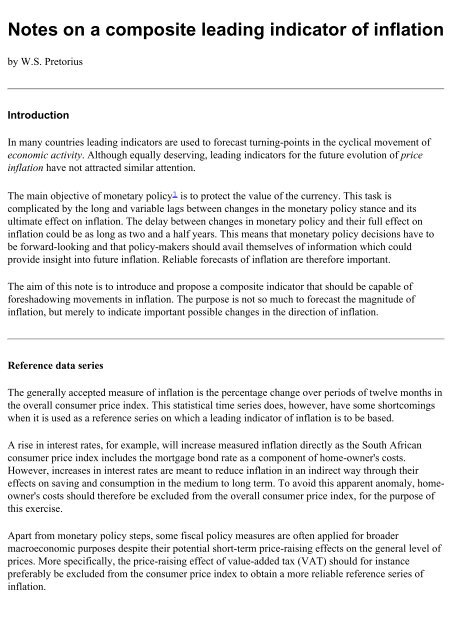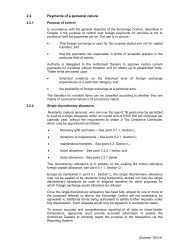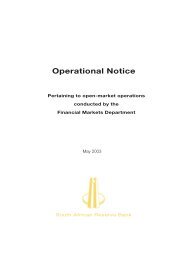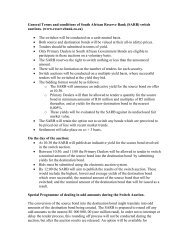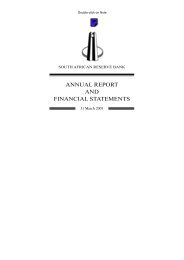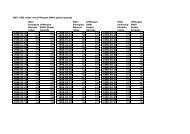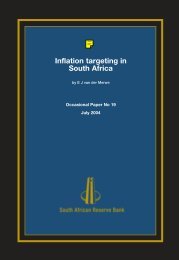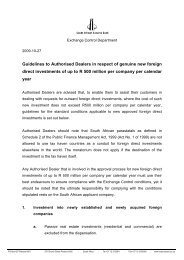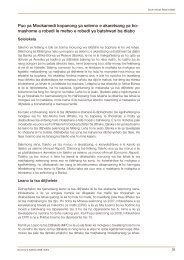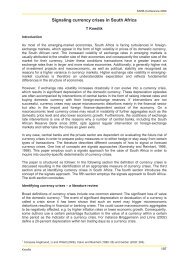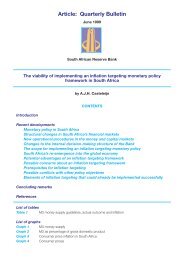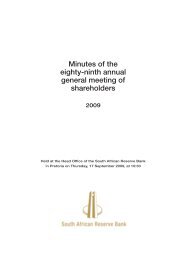Notes on a composite leading indicator of inflation
Notes on a composite leading indicator of inflation
Notes on a composite leading indicator of inflation
You also want an ePaper? Increase the reach of your titles
YUMPU automatically turns print PDFs into web optimized ePapers that Google loves.
<str<strong>on</strong>g>Notes</str<strong>on</strong>g> <strong>on</strong> a <strong>composite</strong> <strong>leading</strong> <strong>indicator</strong> <strong>of</strong> inflati<strong>on</strong><br />
by W.S. Pretorius<br />
Introducti<strong>on</strong><br />
In many countries <strong>leading</strong> <strong>indicator</strong>s are used to forecast turning-points in the cyclical movement <strong>of</strong><br />
ec<strong>on</strong>omic activity. Although equally deserving, <strong>leading</strong> <strong>indicator</strong>s for the future evoluti<strong>on</strong> <strong>of</strong> price<br />
inflati<strong>on</strong> have not attracted similar attenti<strong>on</strong>.<br />
The main objective <strong>of</strong> m<strong>on</strong>etary policy 1 is to protect the value <strong>of</strong> the currency. This task is<br />
complicated by the l<strong>on</strong>g and variable lags between changes in the m<strong>on</strong>etary policy stance and its<br />
ultimate effect <strong>on</strong> inflati<strong>on</strong>. The delay between changes in m<strong>on</strong>etary policy and their full effect <strong>on</strong><br />
inflati<strong>on</strong> could be as l<strong>on</strong>g as two and a half years. This means that m<strong>on</strong>etary policy decisi<strong>on</strong>s have to<br />
be forward-looking and that policy-makers should avail themselves <strong>of</strong> informati<strong>on</strong> which could<br />
provide insight into future inflati<strong>on</strong>. Reliable forecasts <strong>of</strong> inflati<strong>on</strong> are therefore important.<br />
The aim <strong>of</strong> this note is to introduce and propose a <strong>composite</strong> <strong>indicator</strong> that should be capable <strong>of</strong><br />
foreshadowing movements in inflati<strong>on</strong>. The purpose is not so much to forecast the magnitude <strong>of</strong><br />
inflati<strong>on</strong>, but merely to indicate important possible changes in the directi<strong>on</strong> <strong>of</strong> inflati<strong>on</strong>.<br />
Reference data series<br />
The generally accepted measure <strong>of</strong> inflati<strong>on</strong> is the percentage change over periods <strong>of</strong> twelve m<strong>on</strong>ths in<br />
the overall c<strong>on</strong>sumer price index. This statistical time series does, however, have some shortcomings<br />
when it is used as a reference series <strong>on</strong> which a <strong>leading</strong> <strong>indicator</strong> <strong>of</strong> inflati<strong>on</strong> is to be based.<br />
A rise in interest rates, for example, will increase measured inflati<strong>on</strong> directly as the South African<br />
c<strong>on</strong>sumer price index includes the mortgage b<strong>on</strong>d rate as a comp<strong>on</strong>ent <strong>of</strong> home-owner's costs.<br />
However, increases in interest rates are meant to reduce inflati<strong>on</strong> in an indirect way through their<br />
effects <strong>on</strong> saving and c<strong>on</strong>sumpti<strong>on</strong> in the medium to l<strong>on</strong>g term. To avoid this apparent anomaly, homeowner's<br />
costs should therefore be excluded from the overall c<strong>on</strong>sumer price index, for the purpose <strong>of</strong><br />
this exercise.<br />
Apart from m<strong>on</strong>etary policy steps, some fiscal policy measures are <strong>of</strong>ten applied for broader<br />
macroec<strong>on</strong>omic purposes despite their potential short-term price-raising effects <strong>on</strong> the general level <strong>of</strong><br />
prices. More specifically, the price-raising effect <strong>of</strong> value-added tax (VAT) should for instance<br />
preferably be excluded from the c<strong>on</strong>sumer price index to obtain a more reliable reference series <strong>of</strong><br />
inflati<strong>on</strong>.
Accordingly, the reference data series <strong>of</strong> inflati<strong>on</strong> used in this note is the percentage change over<br />
twelve m<strong>on</strong>ths in the overall c<strong>on</strong>sumer price index, excluding home-owner's costs and value-added tax<br />
(see Graph 1).<br />
It could be argued that the prices <strong>of</strong> food which are <strong>of</strong>ten affected by extraneous climatic c<strong>on</strong>diti<strong>on</strong>s<br />
should also be excluded from the c<strong>on</strong>sumer price index. This will reduce the reference data series to<br />
what is comm<strong>on</strong>ly referred to as underlying inflati<strong>on</strong>. Food, however, comprises a substantial part <strong>of</strong><br />
c<strong>on</strong>sumer spending. (The average weight <strong>of</strong> food in the overall c<strong>on</strong>sumer price index is almost 20 per<br />
cent, ranging from about 45 per cent in the case <strong>of</strong> very low expenditure categories to 15 per cent in<br />
the highest expenditure categories.) Furthermore, the impact <strong>of</strong> food prices is dispersed over a wide<br />
variety <strong>of</strong> potential <strong>leading</strong> <strong>indicator</strong>s, thereby frustrating any attempt to eliminate the effect <strong>of</strong> food<br />
prices <strong>on</strong> a <strong>composite</strong> <strong>leading</strong> <strong>indicator</strong>. It was therefore decided not to exclude food from the<br />
reference data series. However, as food prices are subject to abrupt fluctuati<strong>on</strong>s from time to time, they<br />
could introduce corresp<strong>on</strong>ding movements in the reference data series. Although the various<br />
prospective <strong>leading</strong> <strong>indicator</strong>s will be compared with the reference data series, the relati<strong>on</strong>ship<br />
between such <strong>indicator</strong>s and underlying and overall inflati<strong>on</strong> may still be valuable in explaining<br />
particular movements in inflati<strong>on</strong>( see Graph 2).
According to Table 1 the turning-points <strong>of</strong> the reference data series show <strong>on</strong>ly a few deviati<strong>on</strong>s from<br />
those <strong>of</strong> the more comprehensive overall inflati<strong>on</strong> rate. The <strong>on</strong>ly significant difference occurred when<br />
the overall inflati<strong>on</strong> cycle <strong>of</strong> 1989-1990 was not accompanied by a corresp<strong>on</strong>ding cycle in either the<br />
reference or the underlying data series. This can mainly be explained by the str<strong>on</strong>g c<strong>on</strong>tributi<strong>on</strong> <strong>of</strong> a<br />
rise <strong>of</strong> 3 percentage points in the mortgage b<strong>on</strong>d rate between November 1988 and October 1989. In<br />
the period 1994-1995 the overall inflati<strong>on</strong> series again experienced a cycle that was not clearly<br />
reflected in the reference data series and even less so in the underlying inflati<strong>on</strong> series. The major<br />
c<strong>on</strong>tributi<strong>on</strong> to this difference was an increase in the prices <strong>of</strong> food resulting from the lower-thanexpected<br />
growth in agricultural output <strong>on</strong> account <strong>of</strong> the withholding <strong>of</strong> livestock from the market to<br />
replenish herds, as well as frost damage to vegetable producti<strong>on</strong> and drought-related damage to the<br />
wheat crop.<br />
Table 1. Turning-points <strong>of</strong> inflati<strong>on</strong>
Overall Reference Underlying<br />
Trough Feb 1984 Aug 1984 Aug1984<br />
Peak Jan 1986 Jan 1986 Jan 1986<br />
Trough Aug 1988 Oct 1988 Oct 1988<br />
Peak Jun 1989 ... ...<br />
Trough Jul 1990 ... ...<br />
Peak Oct 1991 Jul 1991 Jul 1991<br />
Trough Apr 1994 ... ...<br />
Peak Apr 1995 ... ...<br />
Trough Apr 1996 Oct 1995 May 1996<br />
Identificati<strong>on</strong> <strong>of</strong> <strong>indicator</strong>s<br />
To compile a <strong>composite</strong> <strong>indicator</strong> as accurately as possible, a large number <strong>of</strong> ec<strong>on</strong>omic time series<br />
were evaluated. Those series identified as c<strong>on</strong>sistent reliable predictors <strong>of</strong> inflati<strong>on</strong> were then<br />
combined into a single <strong>composite</strong> <strong>indicator</strong>. The methodology applied was the same as that used to<br />
compile the <strong>leading</strong> business cycle <strong>indicator</strong> in South Africa (Van der Walt 1983 and Van der Walt &<br />
Pretorius 1995).<br />
To reduce the degree <strong>of</strong> subjective discreti<strong>on</strong> in choosing individual <strong>indicator</strong>s, an objective evaluati<strong>on</strong><br />
system similar to those used in various other countries was relied up<strong>on</strong>. The main criteria used in the<br />
evaluati<strong>on</strong> system were the ec<strong>on</strong>omic significance <strong>of</strong> the specific activity or process included in the<br />
<strong>indicator</strong>, the statistical adequacy <strong>of</strong> the data, the historical c<strong>on</strong>formity and the relati<strong>on</strong>ship with the<br />
reference cycle as to the timing <strong>of</strong> changes, the smoothness <strong>of</strong> the time series, and the timely<br />
availability <strong>of</strong> data. Marks or scores were allotted to each criteri<strong>on</strong>. As the reliability <strong>of</strong> ec<strong>on</strong>omic time<br />
series as reference cycle <strong>indicator</strong>s is <strong>of</strong> overriding importance, historical c<strong>on</strong>formity and the timing <strong>of</strong><br />
changes with the reference cycle were regarded as the most important criteria. In accordance with<br />
practices used in other studies (see for example Moore & Shiskin 1967, Beck, Bush & Hayes 1973 and<br />
Zarnowitz & Boschan 1975), those ec<strong>on</strong>omic time series that closely c<strong>on</strong>formed with the specified<br />
criteria were awarded the highest scores.<br />
Evaluati<strong>on</strong> <strong>of</strong> <strong>indicator</strong>s<br />
More than sixty different time series, including quantitative and qualitative <strong>indicator</strong>s, which could
possibly have some relati<strong>on</strong>ship with inflati<strong>on</strong>, were tested for inclusi<strong>on</strong> in the <strong>composite</strong> <strong>leading</strong><br />
<strong>indicator</strong> <strong>of</strong> inflati<strong>on</strong>. Ultimately, nine <strong>indicator</strong>s were selected for incorporati<strong>on</strong> into the <strong>composite</strong><br />
index. Selecti<strong>on</strong> criteria c<strong>on</strong>sisted not <strong>on</strong>ly <strong>of</strong> the highest scores obtained in the evaluati<strong>on</strong> process, but<br />
various activities and processes in the ec<strong>on</strong>omy that may c<strong>on</strong>ceivably reflect the origins <strong>of</strong> inflati<strong>on</strong><br />
were seriously c<strong>on</strong>sidered for inclusi<strong>on</strong> in the <strong>indicator</strong> irrespective <strong>of</strong> whether they have been<br />
awarded the highest scores. Am<strong>on</strong>g these were excess demand, supply shortages, cost increases and<br />
inflati<strong>on</strong> expectati<strong>on</strong>s. In many cases the data series were transformed into percentage changes over a<br />
period <strong>of</strong> twelve m<strong>on</strong>ths to c<strong>on</strong>form with the measurement <strong>of</strong> inflati<strong>on</strong>. In the case <strong>of</strong> time series with<br />
quarterly frequencies, the data were c<strong>on</strong>verted into time series with a m<strong>on</strong>thly frequency.<br />
The nine <strong>indicator</strong>s selected to serve as <strong>leading</strong> <strong>indicator</strong>s <strong>of</strong> inflati<strong>on</strong> are presented in Table 2. These<br />
nine individual comp<strong>on</strong>ents were then combined into a single <strong>composite</strong> <strong>indicator</strong> using the techniques<br />
described by Van der Walt and Pretorius (1995).<br />
Table 2. Leading <strong>indicator</strong>s <strong>of</strong> inflati<strong>on</strong><br />
Indicator<br />
Value <strong>of</strong> retail trade sales at c<strong>on</strong>stant prices<br />
Gross domestic expenditure as percentage <strong>of</strong> gross<br />
domestic product<br />
Output gap (difference between potential and actual<br />
real gross domestic product in the private n<strong>on</strong>agricultural<br />
sectors)<br />
Delivery period <strong>of</strong> orders received in manufacturing<br />
(opini<strong>on</strong> survey)<br />
Unit labour costs in the n<strong>on</strong>-agricultural sectors<br />
Prices <strong>of</strong> imported goods and n<strong>on</strong>-factor services<br />
M3 m<strong>on</strong>ey supply<br />
Yield <strong>on</strong> government stock with maturity <strong>of</strong> 10 years<br />
and l<strong>on</strong>ger<br />
Measuring unit<br />
Percentage change over twelve m<strong>on</strong>ths<br />
Percentage and c<strong>on</strong>verted to m<strong>on</strong>thly<br />
frequency<br />
Percentage and c<strong>on</strong>verted to m<strong>on</strong>thly<br />
frequency<br />
Net percentage and c<strong>on</strong>verted to m<strong>on</strong>thly<br />
frequency<br />
Percentage change over four quarters and<br />
c<strong>on</strong>verted to m<strong>on</strong>thly frequencty<br />
Percentage change over four quarters and<br />
c<strong>on</strong>verted to m<strong>on</strong>thly frequency<br />
Percentage change over twelve m<strong>on</strong>ths<br />
Percentage
Expected average retail selling price (opini<strong>on</strong> survey)<br />
Net percentage and c<strong>on</strong>verted to m<strong>on</strong>thly<br />
frequency<br />
The relati<strong>on</strong>ship between the movement in the <strong>composite</strong> <strong>leading</strong> <strong>indicator</strong> and inflati<strong>on</strong> is indicated in<br />
Table 3 (as well as Graph 3). The changes in the directi<strong>on</strong> <strong>of</strong> the <strong>composite</strong> <strong>indicator</strong> gave early<br />
warnings <strong>of</strong> changes in the directi<strong>on</strong> <strong>of</strong> inflati<strong>on</strong> <strong>on</strong>e to two years ahead <strong>of</strong> the actual change in the<br />
reference data series <strong>of</strong> inflati<strong>on</strong>.<br />
Table 3. Turning-points <strong>of</strong> the <strong>composite</strong> <strong>leading</strong> <strong>indicator</strong><br />
Leading <strong>indicator</strong> Reference data series <strong>of</strong> inflati<strong>on</strong> Lead time (m<strong>on</strong>ths)<br />
Trough Aug 1983 Aug 1984 12<br />
Peak Oct 1984 Jan 1984 15<br />
Trough Feb 1987 Oct 1988 20<br />
Peak May 1989 Jul 1991 26<br />
Trough Nov 1993 Oct 1995 23<br />
Peak Aug 1996* ... ...<br />
* Although the <strong>leading</strong> <strong>indicator</strong> showed a "peak" early in 1995, this "peak" was solely attributable to<br />
two comp<strong>on</strong>ents which increased str<strong>on</strong>gly over a short period, before declining again equally str<strong>on</strong>gly.<br />
Firstly, the str<strong>on</strong>g upward movement <strong>of</strong> domestic rates <strong>on</strong> l<strong>on</strong>g-term b<strong>on</strong>ds in 1994 was caused by<br />
factors such as uncertainties pertaining to political developments and c<strong>on</strong>cern about the government's<br />
large financing needs.<br />
Sec<strong>on</strong>dly, there was a sharp increase in 1994 in the number <strong>of</strong> manufacturers who experienced a<br />
lengthening in the delivery period <strong>of</strong> orders received.
C<strong>on</strong>cluding comments<br />
The <strong>composite</strong> <strong>leading</strong> <strong>indicator</strong> <strong>of</strong> inflati<strong>on</strong> turned out to be a reliable predictor <strong>of</strong> inflati<strong>on</strong> turningpoints<br />
during the 1980s. The forecasting power <strong>of</strong> the <strong>indicator</strong> was broadly left intact in the 1990s. A<br />
deep trough in the <strong>leading</strong> <strong>indicator</strong> in 1993 was followed by a trough in the reference data series in<br />
1995.<br />
After having reached a peak in 1996, the <strong>composite</strong> <strong>leading</strong> <strong>indicator</strong> moved downwards. This<br />
movement still has to be reflected more c<strong>on</strong>vincingly in a further slowdown in the rate <strong>of</strong> increase in<br />
c<strong>on</strong>sumer prices. Movements in inflati<strong>on</strong> in the m<strong>on</strong>ths to come are likely to c<strong>on</strong>firm that the<br />
<strong>composite</strong> <strong>indicator</strong> is still, also under present circumstances, a reliable predictor for the movement in<br />
c<strong>on</strong>sumer price inflati<strong>on</strong>.<br />
References<br />
Beck, M.T., Bush, M.G. & Hayes, R.W. June 1973. The <strong>indicator</strong> approach to the identificati<strong>on</strong> <strong>of</strong><br />
business cycles. Occasi<strong>on</strong>al Paper No. 2. Reserve Bank <strong>of</strong> Australia.<br />
Moore, G.H. & Shiskin, J. 1967. Indicators <strong>of</strong> business expansi<strong>on</strong>s and c<strong>on</strong>tracti<strong>on</strong>s. New York:<br />
Nati<strong>on</strong>al Bureau <strong>of</strong> Ec<strong>on</strong>omic Research, Columbia University Press.<br />
Van der Walt, B.E. March 1983. Indicators <strong>of</strong> business cycle changes in South Africa. Quarterly<br />
Bulletin. Pretoria: South African Reserve Bank.
Van der Walt, B.E. & Pretorius, W.S. March 1995. Business cycles in South Africa during the period<br />
1986 to 1993. Quarterly Bulletin. Pretoria: South African Reserve Bank<br />
Zarnowitz, V. & Boschan, C. May 1975. Cyclical <strong>indicator</strong>s: An evaluati<strong>on</strong> and new <strong>leading</strong> indexes.<br />
Business C<strong>on</strong>diti<strong>on</strong>s Digest. Washingt<strong>on</strong>: US Department <strong>of</strong> Commerce.<br />
1 To attain the ultimate objective <strong>of</strong> price stability, the m<strong>on</strong>etary authorities determine an acceptable<br />
growth rate for the m<strong>on</strong>ey supply as an intermediate objective. The growth in the m<strong>on</strong>ey supply is then<br />
affected by changes in the amount <strong>of</strong> liquidity available in the banking system and by changing the<br />
cost <strong>of</strong> accommodating the m<strong>on</strong>ey market shortage.


